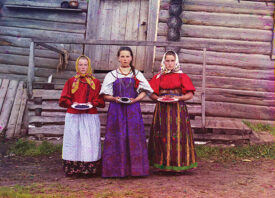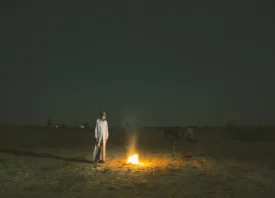Search this site
Photographer Sergei Isaenko Revisits the Soviet Collapse Through Symbolism and Iconography
In August 1991, while living in Vladikavkaz, Russia, my family watched on an old television screen as the tanks rolled over the Red Square in what is now known as the “August Coup”, a civil action to take over the government. Ultimately it led to the final dissolution of the Soviet Union and ushered in the last stage of the Collapse—the tragic ending of an ideological experiment. As the Iron Curtain fell, a mass migration of refugees spread all over the world from under the dying carcass of the Soviet monster in search of a better life.
—Sergei Isaenko
We recently talked to Atlanta-based photographer Sergei Isaenko about his series Echoes of the Collapse, an intricate narrative following an unnamed soldier—a character that Isaenko says represents a part of himself and his family that has been lost in time. The series explores perceptions and portrayals of history, and also forges a relationship with what it means to be displaced in a distant culture.
How did your memories of the Soviet Collapse—the media portrayal of the event and your experience coming of age in Soviet Russia—create the basis for your concept?
“Media and television in particular played a tremendous role in how my family experienced the Collapse. That is why it was integral for me to include that aspect in the project through perpetual symbolism, such as a television set and idyllic cinematic settings reminiscent of Soviet realism.
“In my memory, some of the most profound experiences of the Collapse began with a television broadcast. For example, when the tanks were rolling out on the Red Square and riots were broadcasted nationally in 1989-1991, my family and I watched, just before the experience became a reality on the streets of our city. Tanks were rolling down our main street and people were in distress. Something I saw on a television set became a reality in my life shortly after. A television set in that sense becomes a transcendental device indicative of reality versus fiction. In as much as Echoes of the Collapse is a fictional experience, it is also a great representation of truth.
“The original basis for my concept spanned from the fact that I “escaped” the mandatory military service upon my eighteenth birthday because my parents chose to seek a better life in the United States. I was seventeen when we left. The unfulfilled duty, so to speak, haunts my memory to this day and became a parallel, hypothetical scenario underlining the story in the series.”
You use repetition of symbolism with the placement of television sets, candles, and the color red, among other objects that we see move continuously through the series. How did you intend for this to help, hinder, or create an experience for the viewer to understand your struggles with identity, cultural loss, and displacement?
“The depiction of candles, TV, red and other symbols are pieces of the puzzle that alongside the titles of each image comprise a narrative. Candles in particular are the device meant to guide the viewer through the emotional experience of change. In the photographs where a lit candle is present, it is accompanied by a specific emotional state of a corresponding character(s).
“In Russian Orthodox tradition, candles represent the divine flame or breath and life of a person and are usually placed lit under an icon of a saint, a portrait or a prayer. This tradition is deeply rooted in Russian culture and people always light a candle for a person who goes through hardships or challenges in their life. In Echoes of the Collapse, the lit and extinguished candles represent just that—change, incredible hardship and transformation. In that context, the Unknown Soldier specifically, becomes a saint-like, iconographic figure who represents the hardships and difficulties of not only me and my family, but people of my culture in general.
The use of television sets is particularly haunting to me. You say that your family first watched the Collapse as it was broadcast on television, but does this also suggest a cultural and nationalistic misrepresentation of information from your past, which is also influencing your present? How has media shaped your view of the Collapse, and also other views as well?
“When I was growing up, television in the Soviet Empire was comprised of movies and broadcasts that depicted a perfect Soviet reality; a reality that did not really exist. That is why now, among older generations who lost their identity through the Collapse, a nostalgic myth still exists about such a perfect reality. These people, like my parents, still have their old movies and broadcasts to remind them of the world before. They watch these movies and broadcasts even today with great sentiment and believe in the Soviet myth of perfect reality. They believe in it not because it was real, but because it reminds them of the life which was destroyed by the Collapse.
“When the last breath of the Soviet Empire was drawn, television and media took on a new, destructive role. It began to shift from a comfortable, lethargic, perfect reality to a different one—one which started to include comparisons with the West, ethnocentric and nationalistic ideals, and therefore contributed to the final collapse of the Soviet Empire.
“In the photograph Waiting for Collapse, a man sitting on the train tracks in front of a TV symbolizes the impending collapse. In this case, the television symbolizes a propagandistic tool of the malignant form of nationalism that eventually led to the destruction of the myth about a Soviet paradise, while at the same time created the reality of the “oncoming train”, which would smash the once powerful Empire based on this myth.”
Do you have a particular audience that the work speaks to? Has a cultural gap between the way the Soviet Collapse is portrayed in American media and history books versus your own experience and truth influenced this choice? Why?
“I discovered that most of the American people have a misguided knowledge of what the Collapse and the Soviet reality were, largely due to the same device which contributed to the Collapse—television.
“My goal in this project was to tell the truth about my experience through symbolism and iconography. And, perhaps by doing so, my project will create some better understanding and interest in that historical period. Echoes of the Collapse is most certainly a representation of my experience and my truth, but it doesn’t give a full picture about the extremely complicated case of the Collapse and Soviet life. My goal was to create a bridge that would inspire people to look further and understand better. I believe it is important to carry that history with us, especially in this culture, where a potential collapse could become a future reality.”
This post was contributed by photographer Sara Hopkins.












